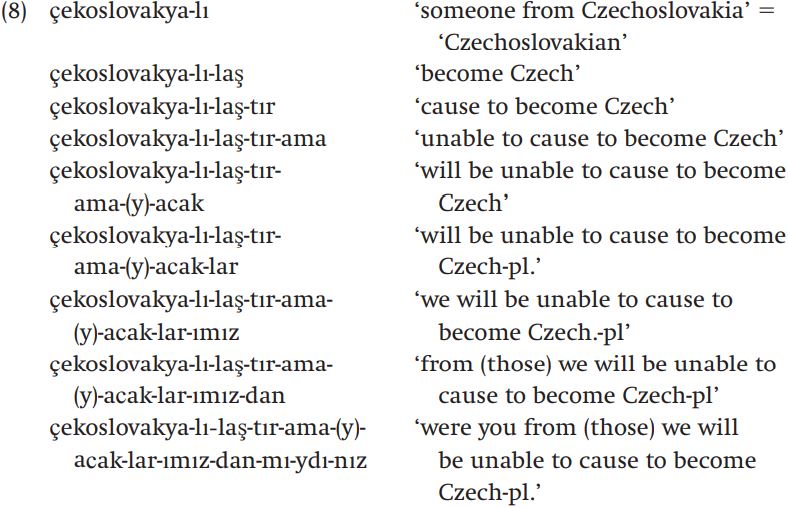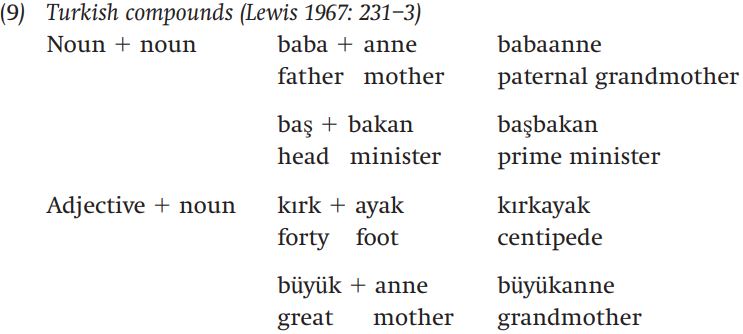


 Grammar
Grammar
 Tenses
Tenses
 Present
Present
 Past
Past
 Future
Future
 Parts Of Speech
Parts Of Speech
 Nouns
Nouns
 Verbs
Verbs
 Adverbs
Adverbs
 Adjectives
Adjectives
 Pronouns
Pronouns
 Pre Position
Pre Position
 Preposition by function
Preposition by function 
 Preposition by construction
Preposition by construction
 Conjunctions
Conjunctions
 Interjections
Interjections
 Grammar Rules
Grammar Rules
 Linguistics
Linguistics
 Semantics
Semantics
 Pragmatics
Pragmatics
 Reading Comprehension
Reading Comprehension|
Read More
Date: 2025-01-15
Date: 2023-12-19
Date: 2023-09-25
|
Imagine one word that means ‘were you one of those whom we are not going to be able to turn into Czechoslovakians?’ This may seem highly unlikely, but it’s possible in Turkish: the word is çekoslovakyalılaştıramayac aklarımızdanmıydınız, and it’s possible because Turkish is a language that delights in suffixation:

Let’s look in detail at the pieces that make up this word. Note first that Turkish has a phonological rule called ‘vowel harmony’ which makes the vowels of suffixes agree with the preceding vowels in the base in backness and sometimes roundness . The first suffix that we encounter after the base is a suffix -li, which attaches to nouns to make personal nouns. With vowel harmony, the suffix -li will show up as -lu after the front round vowel ö:

The next suffix -laş forms intransitive verbs from adjectives. Again, taking vowel harmony into account, the suffix can appear as -leş if it is preceded by a base with front vowels, and -laş if preceded by back vowels:

Next we have the suffix -dir, which forms causative verbs from intransitive verbs. Note that the [d] in the suffix shows up as the corresponding voiceless stop [t] if the preceding consonant is voiceless:

The following suffix is called the ‘impotential’, which essentially means ‘not able’:

Next is the future suffix -ecek:

Then the plural suffix -ler:

And then, we get the first person possessive suffix -ımız, the ablative marker -dan (which essentially means ‘from’), the question marker -mı, the locative marker -dı (which means ‘at’), and the second person plural verb marker -nız. As you can see, each of these suffixes can occur in simpler words, but they can all be used together to form the enormously long and complex word we started with. If we put it all back together again, we get something like (8):

Although the predominant way of forming words in Turkish is through suffixation, it also has a process of compounding, as the examples in (9) show:

As the examples in (9) show, Turkish compounds are right-headed.
We can see from our lengthy discussion of the example in (1) that Turkish uses suffixation for both derivation and inflection. In addition to marking number on nouns, Turkish also marks case, as the paradigm in (10) shows:

Turkish verbs are inflected for person and number, and can appear in a number of different tenses, including present, past, future, and conditional. There are affixes to make verbs negative or interrogative, and verbs can mark other distinctions as well. All of these inflections are suffixes; verb forms can be quite long and complex.
What this brief description of Turkish morphology shows is that a language can have wildly abundant morphology, and yet use no more than a couple of tools from our universal toolkit. Turkish is an overwhelmingly, exuberantly suffixing language, using suffixes for both lexeme formation and inflection, but it has no processes of prefixation to speak of. What few prefixes can be found in Turkish are always on borrowed words, and essentially are not part of the native system of word formation of Turkish.
|
|
|
|
هل يمكن أن تكون الطماطم مفتاح الوقاية من السرطان؟
|
|
|
|
|
|
|
اكتشاف عرائس"غريبة" عمرها 2400 عام على قمة هرم بالسلفادور
|
|
|
|
|
|
|
جامعة الكفيل تقيم ندوة علمية عن الاعتماد الأكاديمي في جامعة جابر بن حيّان
|
|
|